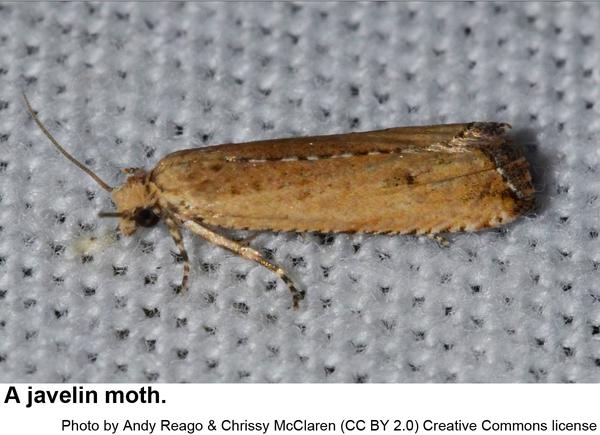Description and Biology
Caterpillars in the family Tortricidae, genus Bactra, have specialized in feeding on sedges and rushes. Moths in this genus are usually light brown, small (1/2 to 3/4 inch wingspan), and variously spotted and mottled. The forewings are narrow and somewhat pointed at the tip and sometimes have a number of darker brown areas. The hind wings are sooty-brown. Although most of the tortricids are leaftiers and leafrollers, some Bactra tortricids bore into their hosts to feed. Caterpillars in this genus do not have common names except for Bactra venosana, the nutgrass borer moth, and the javelin moth, Bactra verutana. The nutgrass borer has been released in the Philippines, Hawaii and Fiji to control nutsedges biologically. The javelin moth infests purple nutsedge and yellow nutsedge as early as May, but is more common later in the summer and into September and October when as many as 84% of wild yellow nutsedges may be infested. We probably have two generations per year. The adults are readily attracted to lights at night especially near marshy areas. Descriptions of the eggs, caterpillars, and pupae do not seem to be available.
Host Plants
The javelin moth caterpillars bore into sedges and rushes where they feed on leaves, fascicles and basal bulbs.
Residential Recommendations
Once javelin moth caterpillars have been noticed, consider using a pyrethroid insecticide at monthly intervals to protect ornamental sedges and rushes from further damage. Pyrethroids are very toxic to caterpillars, are repellent to insects, but are not too hazardous to humans and pets when used as directed. Because they often feed on plants along waterways and ponds, control of javelin moth caterpillars is somewhat more complicated than control of most other leaf-feeding insects on ornamentals. Pyrethroids are very toxic to fish so these pesticides should be applied in a manner than prevents contamination of lakes and streams. Pyrethroids labeled for residential landscape use are readily available in most big box stores, plant centers, and nurseries. The active ingredient of pyrethroids ends with "-thrin." The active ingredient of all pesticides are listed on the front label usually in very small font near the bottom. Most pyrethroids have a long residual life in the environment.
Other Resources
- Bactra verutana ->species page. Bird, C. D. 2005. Entomology Collection, University of Alberta E.H. Strickland Entomological Museum
- Bactra lancealana (Hübner, [1799]). Ian Kimber. 2020. UK Moths.
- Biocontrol of Purple Nutsedge by Bactra verutana Zeller in a Greenhouse. K. E. Frick and P. C. Quimby, Jr. 1977. Weed Science 25 (1): 13-17.
- Javelin Moth, Bactra verutana. Anonymous. 2025. Calscape, California Native Plant Society.
- Guide to the Olethreutine Moths of Midland North America (Tortricidae). Miller, W. E. 1987. U.S. Dept. of Agriculture, Forest Service. 104 pp.
- NC State Extension Plant Pathology Publication
- NC State Horticultural Science Publications
- North Carolina Agricultural Chemicals Manual
For assistance with a specific problem, contact your local N.C. Cooperative Extension center.
This factsheet has not been peer reviewed.
Publication date: July 20, 2020
Reviewed/Revised: May 8, 2025
Recommendations for the use of agricultural chemicals are included in this publication as a convenience to the reader. The use of brand names and any mention or listing of commercial products or services in this publication does not imply endorsement by NC State University or N.C. A&T State University nor discrimination against similar products or services not mentioned. Individuals who use agricultural chemicals are responsible for ensuring that the intended use complies with current regulations and conforms to the product label. Be sure to obtain current information about usage regulations and examine a current product label before applying any chemical. For assistance, contact your local N.C. Cooperative Extension county center.
N.C. Cooperative Extension prohibits discrimination and harassment regardless of age, color, disability, family and marital status, gender identity, national origin, political beliefs, race, religion, sex (including pregnancy), sexual orientation and veteran status.



